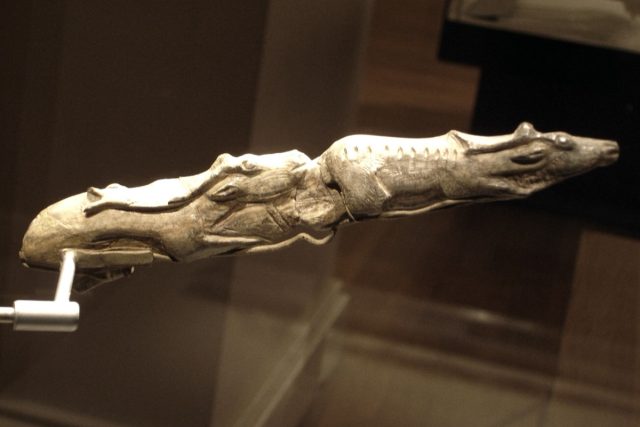

Stone Age people may have gathered at night to watch animated “fireside art”
source link: https://arstechnica.com/science/2022/04/stone-age-people-may-have-gathered-at-night-to-watch-animated-fireside-art/
Go to the source link to view the article. You can view the picture content, updated content and better typesetting reading experience. If the link is broken, please click the button below to view the snapshot at that time.
Paleolithic portable art —
Stone Age people may have gathered at night to watch animated “fireside art”
VR simulations showed firelight would make images on engraved stones move and flicker.
Jennifer Ouellette - 4/21/2022, 12:30 PM
In 1866, a French engineer named Peccadeau de l'Isle was working on the construction of a railway line in southern France, digging for artifacts along the banks of the River Aveyron in his spare time. Some 23 feet (7 meters) down, he found a number of prehistoric flint tools and prehistoric art. They included the famed Swimming Reindeer sculpture and a carved spear thrower in the shape of a mammoth, as well as numerous engraved flat stones called plaquettes, all created by the Magdalenian people sometime between 16,000 and 13,500 years ago.
The finds caused a sensation at the time, mostly because they provided evidence of a colder climate during this period and that men had co-existed during the ice age with mammoths. A new analysis by English archaeologists of the limestone plaquettes excavated by de l'Isle concludes that the stones may have been placed around fire hearths. The team's digital reconstructions showed that the engraved images would appear to move and flicker in the firelight, amounting to a kind of animated "fireside art." The details appear in a new paper published in the journal PLoS ONE.
“This must have been quite a powerful visual effect,” co-author Andrew Needham of the University of York told New Scientist—particularly in the context of a campfire. “This was likely an important social space. It might have been a place to share stories or chat and bond with each other after long days spent out in the landscape hunting and gathering. The art is not just the engraved lines on the rock, but those engraved lines experienced under the correct conditions of darkness and roving light. It changes our appreciation of what art was and how it was used by Magdalenian people.”

Earlier cave-art lighting discoveries
In fact, the lighting conditions would have been very similar to those for prehistoric cave paintings, which also may have played with light and shadow to create "protomovies." That's a concept that surfaced in the 1990s, after a media studies professor at Fordham University named Edward Wachtel visited several famous caves in southern France, including Lascaux, Font-de-Gaume, Les Combarelles, and La Mouthe. Wachtel was puzzled by what he called "spaghetti lines" on the drawings, partially obscuring them. There were also images of an ibex with two heads, or a bull drawing superimposed over the drawing of a deer.
Advertisement
Inspiration struck when the local farmer serving as his guide swung the lantern inside the cave. The color schemes shifted, and the engraved lines seemed to animate. Wachtel subsequently published a paper entitled, "The First Picture Show: Cinematic Aspects of Cave Art," in which he concluded that the cave drawings were meant to be perceived in three dimensions—one of them being time.
Wachtel's ideas are admittedly speculative, albeit intriguing, given the lack of archaeological context for these ancient settings. But Needham and others in the field are combining established methods—such as micro- and macroscopic analysis and 3D modeling—with experimental archaeological and virtual reality modeling to reconstruct the conditions of this Paleolithic period in hopes of learning more.
For instance, last year, we reported on how a team of Spanish scientists conducted in situ experiments with three different kinds of Paleolithic lighting sources in the hopes of discovering what those various illumination methods might tell us about the emergence of "human symbolic and artistic behavior" in the form of cave art. The team conducted their experiments at the Isuntza 1 Cave in Spain's Basque country.

They chose two distinctive spaces—a large, wide chamber and a smaller chamber, connected by a rough passage—and performed eight experiments involving torches, stone lamps with animal fat, and a small fireplace. Their measurements showed that the various lighting sources had very different characteristics and, thus, were probably used in different contexts. The Spanish team also built a virtual 3D model to examine the lighting conditions of a section of the Atxurra Cave known as the Ledge of the Horses, which boasts two panels of about 50 animal engravings: bison, goats, horses, and hinds, many of them overlapping.
Their findings had no direct bearing on Wachtel's speculation about prehistoric cinematic art. But the scientists argued that the more archaeologists learn about Paleolithic lighting sources, the more we will understand about how those lighting sources affect human perception in a cave environment, with implications for the emergence of cave art.
Page:
Recommend
About Joyk
Aggregate valuable and interesting links.
Joyk means Joy of geeK